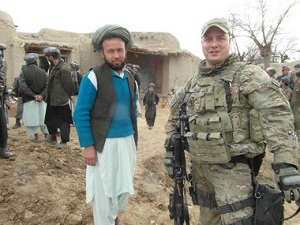
When thinking about the US Army we tend to forget that it is not homogenous and is not comprised entirely of people whose job is to take part in actual fighting. There are other subdivisions with their own specific goals and purposes, and the US Army Civil Affairs is one of them.
It can be best characterized as a division of war diplomats – their main job is to maintain relations with civil authorities of areas of military operations, communicate with locals, and, in general, make sure that the negative impact of these operations is kept to a minimum, local authorities get all the help they need and people suffer as little as possible.
The majority of US Army Civil Affairs officers are reservists who support and accompany active duty military units. The fact that their members usually come from Army Reserve means that they already possess certain experience in non-military occupations and don’t have to be specifically trained for their job, which may vary from lawyers and economists to teachers and doctors.
Thus, Civil Affairs Soldiers come from all kinds of backgrounds and areas of expertise, making sure that field commanders have full range of specialists at their disposal. They provide a link to local authorities and make sure that civil administration is carried out as smoothly and stably as it is possible under the circumstances.
Although their job doesn’t look all that heroic and they are often perceived as a kind of supplement to ‘real’, active duty soldiers, US Army Civil Affairs plays vital role in day-to-day workings of military forces. After all, they try to minimize the negative impact of war on people who have nothing to do with it and, on the contrary to common belief, do it not from a headquarters 2000 miles away from the zone of active warfare, but right on the spot.
All in all, yes, they can be called a supplement, but only in the sense of doing the same job by different means. Instead of using active force they are engaged in low-profile jobs spread in the zone of conflict and aim to strengthen and stabilize friendly governments while indirectly battling destabilizing elements.
Civil Affairs has only existed as a separate branch of military forces since 2007, but during this time it has been growing rapidly, recruiting new people and undergoing general restructuring – the majority of its soldiers are still reservists, but the amount of active component soldiers saw a dramatic increase: from 4% to about 30%. With two wars going on simultaneously there was simply not enough reservists to satisfy all the needs of the army, which meant that the force had to be rebuilt and reformed according to the changing world situation.
The most characteristic aspect of Civil Affairs is the wide variety of activities they take part in, ranging from building earthquake shelters and supporting local military hospitals to carrying out anti-drug operations and training local law enforcement officers.
Usually Civil Affairs soldiers are deployed in teams of four, comprised of a captain and three non-commissioned officers, all of whom are generally regional experts with deep knowledge of the target location’s local culture, language, economic and political situations.
Usually they don’t work autonomously and support Special Operations, conventional army units or military forces of partner nations, providing a non-lethal edge to the policies carried out by the United Stated in the region.
By and large, it can be said that US Army Civil Affairs exists mainly in order to provide the Army with a human face, a face that others can relate to, which is not as intimidating as the Army in general.